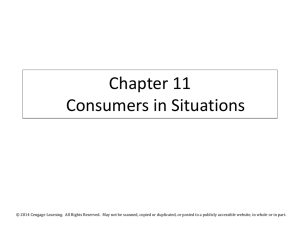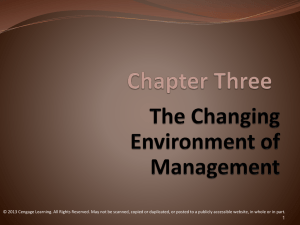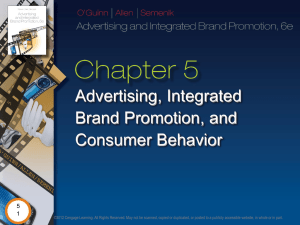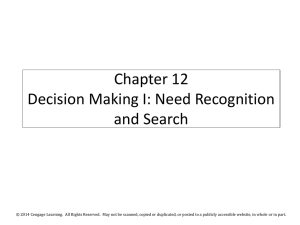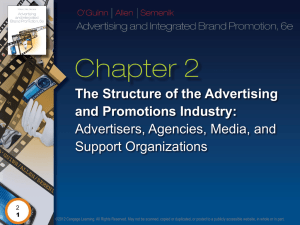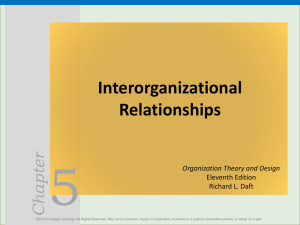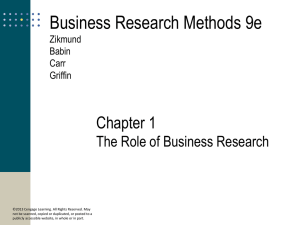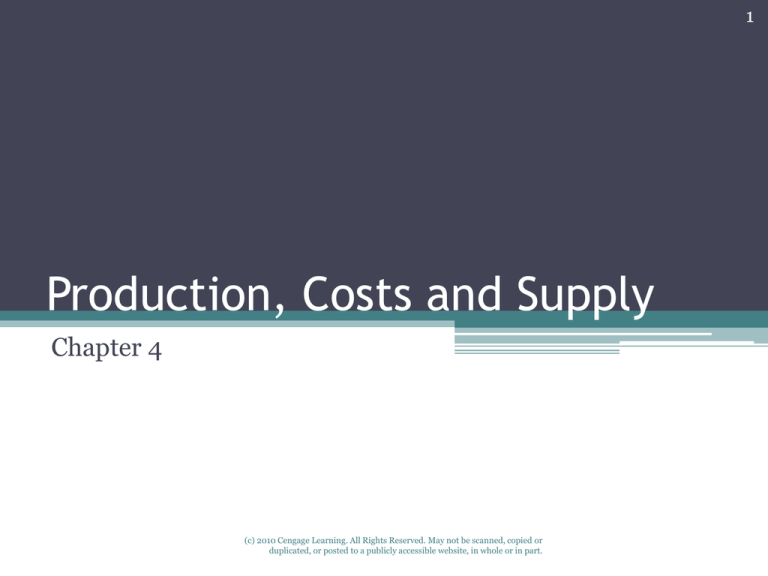
1
Production, Costs and Supply
Chapter 4
(c) 2010 Cengage Learning. All Rights Reserved. May not be scanned, copied or
duplicated, or posted to a publicly accessible website, in whole or in part.
2
(c) 2010 Cengage Learning. All Rights Reserved. May not be scanned, copied or
duplicated, or posted to a publicly accessible website, in whole or in part.
3
The Biggest Machine in the World
This is the control room of the California Independent System
Operator (Cal-ISO, or just ISO) in Folsom, California, producing
and delivering power to 80 percent of the state’s households and
businesses.
(c) 2010 Cengage Learning. All Rights Reserved. May not be scanned, copied or
duplicated, or posted to a publicly accessible website, in whole or in part.
4
What’s Next
Cal-ISO and its computers must control as many as
800 electrical generators and 30,000 miles of
high-voltage transmission lines, seeing to it that
total power produced always equals exactly
the amount people wish to use. Furthermore, they
must do so in a way that minimizes their cost.
We will touch on almost all of Cal-ISO’s
cost-related problems in this chapter.
(c) 2010 Cengage Learning. All Rights Reserved. May not be scanned, copied or
duplicated, or posted to a publicly accessible website, in whole or in part.
5
(c) 2010 Cengage Learning. All Rights Reserved. May not be scanned, copied or
duplicated, or posted to a publicly accessible website, in whole or in part.
6
Production
Production is the act of transforming resources into
goods and services that are more valuable.
For example, oil is extracted from the ground, refined into
gasoline, and used as transportation fuel, or, a hair stylist uses
time, scissors, and chemicals to make a customer feel more
attractive and self-confident, which is potentially of great value
for a job interview, or, an intermediary finds a previously
undiscovered low-cost source of a good that allows her to resell
it for less than competitors would charge.
(c) 2010 Cengage Learning. All Rights Reserved. May not be scanned, copied or
duplicated, or posted to a publicly accessible website, in whole or in part.
7
Outputs, Inputs, and Business Firms
A firm combines inputs to produce output. A firm’s
production function is the relationship between it’s
inputs and output.
(c) 2010 Cengage Learning. All Rights Reserved. May not be scanned, copied or
duplicated, or posted to a publicly accessible website, in whole or in part.
8
(c) 2010 Cengage Learning. All Rights Reserved. May not be scanned, copied or
duplicated, or posted to a publicly accessible website, in whole or in part.
9
Opportunity Cost and Its Complications
- The Economist, the Accountant, and
the Newlywed
When economists and accountants discuss costs they
sometimes sound as if they come from different
planets. The economist calls the cost of some action
the most valuable alternative forgone by the decision
maker.
Opportunity cost reasoning sharpens our understanding
of resource allocation.
(c) 2010 Cengage Learning. All Rights Reserved. May not be scanned, copied or
duplicated, or posted to a publicly accessible website, in whole or in part.
10
Opportunity Cost and Its Complications
- Exactly What Is the Forgone
Alternative?
The opportunity cost of self-financing your business is the return on
your best alternative investment, but what might that investment be,
and what does “best” mean?
Before giving up on the concept of opportunity costs, think of how
often they are easy to identify. For many productive inputs, market
prices reliably measure opportunity costs.
Opportunity cost reasoning also helps us understand
broader issues. For example, opportunity cost might even help
explain why higher earners spend less time asleep on average than
those who make less.
(c) 2010 Cengage Learning. All Rights Reserved. May not be scanned, copied or
duplicated, or posted to a publicly accessible website, in whole or in part.
11
Substitution: The Short Run and the
Long
The short run is defined as the length of time during
which the decision maker can vary some inputs, although
others remain fixed. In the long run
all inputs are variable.
Short run and long run are not fixed lengths of time. One
can lease a storefront, furnish it, and hire staff to open a
manicure salon in a matter of weeks. A new power plant
can take eight years from siting to operation.
(c) 2010 Cengage Learning. All Rights Reserved. May not be scanned, copied or
duplicated, or posted to a publicly accessible website, in whole or in part.
12
(c) 2010 Cengage Learning. All Rights Reserved. May not be scanned, copied or
duplicated, or posted to a publicly accessible website, in whole or in part.
13
Production with One Variable Input –
Marginal Cost Again
Consider a steam boiler. The
size of the boiler is fixed but
the amount of fuel added to
the boiler will determine
how much steam is
produced.
To the right is the total
product curve for fuel.
(c) 2010 Cengage Learning. All Rights Reserved. May not be scanned, copied or
duplicated, or posted to a publicly accessible website, in whole or in part.
14
Production with One Variable Input –
Marginal Cost Again
If we know the cost of fuel, we can
turn the total product curve into a
total variable and a marginal cost
curve. The slope of the total
variable cost curve at any point is
the marginal cost of production.
The only part of the marginal cost
curve that matters for production is the
upward sloping portion. If the market
price were $1.50, output should be
expanded to the point where P=MC in
order to maximize profit.
(c) 2010 Cengage Learning. All Rights Reserved. May not be scanned, copied or
duplicated, or posted to a publicly accessible website, in whole or in part.
15
Production with One Variable Input –
Average Variable Cost
From the total variable cost (TVC)
curve we can derive the average
variable cost (AVC) curve. For any
point on the TVC curve, the AVC
is equal to the slope of a ray from
the origin to that point.
(c) 2010 Cengage Learning. All Rights Reserved. May not be scanned, copied or
duplicated, or posted to a publicly accessible website, in whole or in part.
16
Production with One Variable Input –
Marginal Cost One More Time
When MC<AVC, the AVC
Is declining. When MC>AVC,
The AVC is increasing. When
MC=AVC, AVC is at its
Minimum.
(c) 2010 Cengage Learning. All Rights Reserved. May not be scanned, copied or
duplicated, or posted to a publicly accessible website, in whole or in part.
17
Production with One Variable Input
Here are the short-run cost curves
all together. If the price for this
firm’s product was $2.24, the
profit maximizing firm would
expand production to the point
where P=MC, or 79.5 units.
(c) 2010 Cengage Learning. All Rights Reserved. May not be scanned, copied or
duplicated, or posted to a publicly accessible website, in whole or in part.
18
The Short-Run Supply Curve
A firm’s short-run supply
curve is the portion of its
MC curve above the AVC
curve. When price falls
below the firm’s minimum
AVC, the firm will
shut-down and produce
nothing in the short-run.
(c) 2010 Cengage Learning. All Rights Reserved. May not be scanned, copied or
duplicated, or posted to a publicly accessible website, in whole or in part.
19
(c) 2010 Cengage Learning. All Rights Reserved. May not be scanned, copied or
duplicated, or posted to a publicly accessible website, in whole or in part.
20
Isoquants and Isocosts - Isoquants
Isoquants show the various
combinations of two inputs
that can be used to produce a
given level of output.
The isoquants drawn here
show the various
combinations of boiler
capacity (K) and fuel (F)
that can be used to produce
steam.
(c) 2010 Cengage Learning. All Rights Reserved. May not be scanned, copied or
duplicated, or posted to a publicly accessible website, in whole or in part.
21
Isoquants and Isocosts - Isocosts
An isocost line shows the
various combinations of
inputs that will cost a given
amount to purchase.
If fuel is available a $2 per
unit and capital at $4 per
unit, the two isocost lines
at the right show the
combinations of fuel and
capital that can be purchased
for $20 and $40.
(c) 2010 Cengage Learning. All Rights Reserved. May not be scanned, copied or
duplicated, or posted to a publicly accessible website, in whole or in part.
22
Isoquants and Isocosts - Isocosts
If the price of fuel changes
the isocost line pivots as
shown at the right.
Another way to say this is
that the slope of the isocost
line changes.
(c) 2010 Cengage Learning. All Rights Reserved. May not be scanned, copied or
duplicated, or posted to a publicly accessible website, in whole or in part.
23
Minimizing the Cost of a Given Output
The cost minimizing way to
produce 10,000 cubic feet
of steam per hour is determined
by where an isocost line is
just tangent to the isoquant for
Q=10,000.
When K = 4.46 and F = 5.95,
10,000 cubic feet of steam
will be produced at the least
total cost.
(c) 2010 Cengage Learning. All Rights Reserved. May not be scanned, copied or
duplicated, or posted to a publicly accessible website, in whole or in part.
24
Minimizing the Cost of a Given Output
The least cost mix of inputs will by the one for which:
The marginal product of the last dollar spent on F
must equal that of the last dollar spent on K.
(c) 2010 Cengage Learning. All Rights Reserved. May not be scanned, copied or
duplicated, or posted to a publicly accessible website, in whole or in part.
25
The Expansion Path and Long-Run Total
Cost
The expansion path
identifies the lowest longrun total cost of producing
any level of output.
(c) 2010 Cengage Learning. All Rights Reserved. May not be scanned, copied or
duplicated, or posted to a publicly accessible website, in whole or in part.
26
(c) 2010 Cengage Learning. All Rights Reserved. May not be scanned, copied or
duplicated, or posted to a publicly accessible website, in whole or in part.
27
The Shape of Long-Run Average Cost
As long as the long-run average
cost curve is sloping downward,
as from A to C, the firm is
experiencing economies of
scale. When the long-run average
cost curve slopes upward, as from
C to B, the firm is experiencing
diseconomies of scale.
(c) 2010 Cengage Learning. All Rights Reserved. May not be scanned, copied or
duplicated, or posted to a publicly accessible website, in whole or in part.
28
Long-Run Average Cost and
Competition – Natural Monopoly
Consider the short and longrun average cost curves for
the natural gas industry with
a total market consumption
of 2 billion cubic feet per day
(bcfd).
This illustrates a natural
monopoly because the longrun average cost declines
all the way up to the size of
the market.
(c) 2010 Cengage Learning. All Rights Reserved. May not be scanned, copied or
duplicated, or posted to a publicly accessible website, in whole or in part.
29
Long-Run Average Cost and
Competition – Why Might LRAC Slope
Upward?
Diseconomies of scale might arise because larger
firms place such demands on management that
even the most talented executives would
eventually lose the ability to control costs.
Alfred Marshall reasoned that a single
manager or a small group of them would
ultimately be unable to monitor the
performance of a large workforce or to efficiently
coordinate the many different activities that take
place in a large firm.
(c) 2010 Cengage Learning. All Rights Reserved. May not be scanned, copied or
duplicated, or posted to a publicly accessible website, in whole or in part.
30
Long-Run Average Cost and
Competition – Shifts in LRAC
An improvement in
technology might cause
a firms LRAC to shift down
with the minimum point
moving to the left.
(c) 2010 Cengage Learning. All Rights Reserved. May not be scanned, copied or
duplicated, or posted to a publicly accessible website, in whole or in part.
31
Learning
This learning curve
illustrates the idea
that experience
results in a decline
in the time needed
to produce
aircraft.
(c) 2010 Cengage Learning. All Rights Reserved. May not be scanned, copied or
duplicated, or posted to a publicly accessible website, in whole or in part.


